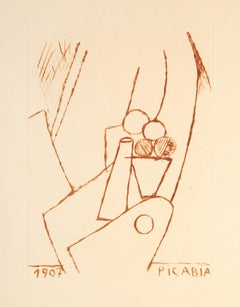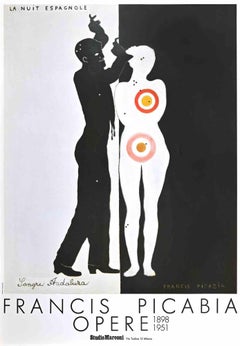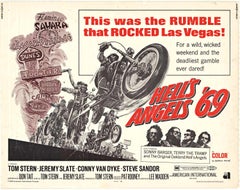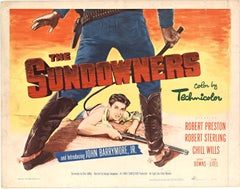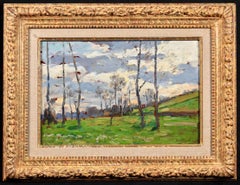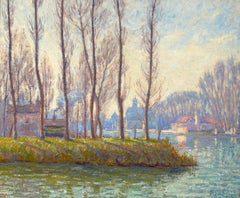Francis Picabia Art
to
6
2
8
3
3
2
2
1
1
1
1
1
Machine Cubiste, Abstract Drypoint by Francis Picabia
By Francis Picabia
Located in Long Island City, NY
Francis Picabia, French (1879 - 1953) - Machine Cubiste, Year: 1907, Medium: Drypoint on Japon, signed and dated in the plate, Image Size: 7 x 5 inches, Size: 10 x 7.5 in. (25.4 x ...
Category
Early 1900s Abstract Francis Picabia Art
Materials
Drypoint
Au Cimetière Monsieur- Pencil and Watercolor on Paper by F. Picabia - 1931
By Francis Picabia
Located in Roma, IT
Au Cimetière Monsieur... is a black pencil and watercolor drawing realized by Francis Picabia in 1931.
Hand signed lower left, with title lower right.
A certificate of inclusion in the Catalog Raisonné being prepared by the Picabia Committee, dated 30 October 2019, will be delivered in original along with the work.
Drawing originally realized by Picabia to illustrate the important volume "Le Peseur d'Ames" by André Maurois, published by Editions Antoine Roche in 1931.
Though specifically realized for the volume, the drawing was not selected for publication and remained in the artist's personal collection.
Cm. 27,4x22.
Good conditions.
Francis Picabia (1879-1953) was born in Paris to a french mother and a Spanish father who was chancellor at the Cuban embassy in Paris. He had a comfortable childhood, even though he was emotionally troubled. He studied at the École nationale supérieure des beaux-arts. At the beginning of his career, from 1908 to 1913, he was strongly influenced first by the Barbizon School and by Alfred Sisley and Camille Pissarro, then by impressionism, cubism and finally abstractionism. Around 1911 he joined the Puteaux Group which he met in the studio of Jacques Villon in the village of Puteaux. He then became friends with the artist Marcel Duchamp. Some members of the group were Apollinaire, Albert Gleizes, Roger de La Fresnaye, Fernand Léger and Jean Metzinger.
From 1913 to 1915 Picabia was often in New York. These years can be identified as the proto-Dada period, which consists mostly of the so-called mechanical portraits (portraits méchaniques): these works ironically proposed mechanistic themes of random tangles of metal parts, paintings and drawings of machines. All these mechanisms on the one hand mocked the cult of the machine, on the other they alluded to sexual intercourse...
Category
1930s Modern Francis Picabia Art
Materials
Watercolor, Paper, Pencil
1950 original poster by Francis Picabia - Le Beau Temps in Alès
By Francis Picabia
Located in PARIS, FR
Poster printed in lithography after a drawing by Francis Picabia, designed for the opening in May 1950 of the bookstore (owned by Pierre-André Benoît) ...
Category
1950s Dada Francis Picabia Art
Materials
Paper, Lithograph
Picabia La Nuit Espagnole - Poster Exhibition by Francis Picabia- 1986
By Francis Picabia
Located in Roma, IT
Picabia La Nuit espagnole - Poster Exhibition is a mixed colored offset print realized in 1986.
This print was realized on the occasion of the exhibition dedicated to the artist and...
Category
1980s Modern Francis Picabia Art
Materials
Paper, Offset
Picabia La Nuit Espagnole - Poster Exhibition by Francis Picabia- 1986
By Francis Picabia
Located in Roma, IT
Picabia La Nuit espagnole - Poster Exhibition is a mixed colored offset print realized in 1986.
This print was realized on the occasion of the exhibition dedicated to the artist and...
Category
1980s Modern Francis Picabia Art
Materials
Paper, Offset
Trois personnages nus
By Francis Picabia
Located in Palm Desert, CA
"Trois personnages nus" is a black conté crayon drawing on buff papaer by Francis Picabia. The artwork is signed in crayon, lower left, "Francis Picabia". The framed work measures 27 1/2 x 24 x 1 1/2 in. The Comité Francis Picabia has confirmed the authenticity of this drawing.
Francis Picabia was an important French painter who experimented with a wide range of styles throughout his career and whose writings about art were influential in the development of the Dada movement...
Category
1920s Francis Picabia Art
Materials
Conté, Paper, Crayon
Le Peseur d’Ames - Rare Book Illustrated by Francis Picabia- 1931
By Francis Picabia
Located in Roma, IT
Le Peseur d’Ames is an original rare book illustrated by Francis Picabia (1879 - 1953) and written by André Maurois (1885 – 1967) in 1931.
Original Fi...
Category
Early 20th Century Modern Francis Picabia Art
Materials
Paper
Couple, The Kiss - Original Ink Drawing, Handsigned
By Francis Picabia
Located in Paris, FR
Francis PICABIA
Couple, The Kiss, 1949
Original Ink Drawing
Handsigned 'Francis' on the back
On paper 27 x 21 cm (c. 11 x 8 in)
This drawing is on the first side of a letter. On the...
Category
1940s Modern Francis Picabia Art
Materials
Ink
Related Items
Original Hell's Angels '69 vintage motorcycle movie poster half-sheet
Located in Spokane, WA
Original Hell's Angels '69 vintage half-sheet movie poster.
Original horizontal half sheet movie poster from 1969: Hell's Angeles '69. The film stars the original Oakland Hell's Angeles with Tom Stern, Jeremy Slate, Conny Van Dyke; Steve Sandor, Sonny Barger, Terry the Tramp. Am American International Release original. 'For a wild, wicked weekend and the deadliest gamble ever dared!. The left-hand side features the famous landmark hotel signs from Flamingo Sahara, Caesars Palace...
Category
1960s American Modern Francis Picabia Art
Materials
Offset
H 22 in W 28 in D 0.04 in
Original 1950 'The Sundowners' vintage movie poster half sheet
Located in Spokane, WA
Original vintage movie poster: "The Sundowners" is a 1950 American film directed by George Templeton. Horizontal half sheet U. S. Movie poster. The Sundowners is a 1950 American ...
Category
1950s American Modern Francis Picabia Art
Materials
Offset
Spanish Artist signed limited edition original art print chine colle drypoint
By Eduardo Chillida
Located in Miami, FL
Eduardo Chillida (Spain, 1924-2002)
'Korapillo II', 1982
chine colle, dry point on japanese paper
25.6 x 19.7 in. (65 x 50 cm.)
Edition of 50. Original 63 of which 50 belong to the regular edition. P/A: 8, H.C.: 5
Unframed
ID: CHI1038-013
Hand-signed by author
It is documented in Chillida, E. (1999). Eduardo Chillida – Opus P. II 1973-1985. Chorus – Verlag, pp 290 – 291. Nr 82003.
____________________________________________________
He began his career in 1943 studying architecture at the University of Madrid, but in 1947 he dedicated himself to drawing and sculpture, and in 1948 he moved to Paris, then the world capital of the arts. Although he abandoned his studies, his work betrays his architectural training, showing an underlying sense of structural organization, as well as discipline in materials, planning of spatial relationships, and scale of elements.
Over the years, the artist turned to materials that showed his investigations into conceptual questions and metaphysical concerns. Chillida's first stone and plaster creations oscillated between the human world and the natural world using figures and images of landscapes.
Consistently guided by the quality of space, density and rhythm, his works consider ways in which mass and volume contain space. His public works, which exist on a more massive scale, not only inhabit the space but also determine a qualifying space of their own.
His monumental sculptures, designed for both urban and more secluded spaces, are permanently installed internationally and constitute an important facet of his artistic production.
The main retrospectives of Chillida's graphic and sculptural work have been mounted by the Museum of Fine Arts in Houston (1966); Carnegie Institute, Pittsburgh (1979); National Gallery of Art, Washington, DC (1979); Guggenheim Museum (1980); Miramar Palace, San Sebastián (1992); and Museo Nacional Centro de Arte Reina Sofía, Madrid (1999).
Chillida received numerous awards, including the Grand International Prize for Sculpture at the Venice Biennale (1958), the Kandinsky Prize (1960), the Carnegie Prize for Sculpture (1964), the Andrew Mellon...
Category
1980s Abstract Francis Picabia Art
Materials
Paper, Drypoint
Spanish Artist signed limited edition original art print chine colle drypoint
By Eduardo Chillida
Located in Miami, FL
Eduardo Chillida (Spain, 1924-2002)
'Korapillo I', 1982
chine colle, dry point on japanese paper
25.6 x 19.7 in. (65 x 50 cm.)
Edition of 50. Original 62 of which 50 belong to the regular edition. P/A: 7, H.C.: 5
Unframed
ID: CHI1038-012
Hand-signed by author
It is documented in Chillida, E. (1999). Eduardo Chillida – Opus P. II 1973-1985. Chorus – Verlag, pp 288 – 289. Nr 82002.
____________________________________________________
He began his career in 1943 studying architecture at the University of Madrid, but in 1947 he dedicated himself to drawing and sculpture, and in 1948 he moved to Paris, then the world capital of the arts. Although he abandoned his studies, his work betrays his architectural training, showing an underlying sense of structural organization, as well as discipline in materials, planning of spatial relationships, and scale of elements.
Over the years, the artist turned to materials that showed his investigations into conceptual questions and metaphysical concerns. Chillida's first stone and plaster creations oscillated between the human world and the natural world using figures and images of landscapes.
Consistently guided by the quality of space, density and rhythm, his works consider ways in which mass and volume contain space. His public works, which exist on a more massive scale, not only inhabit the space but also determine a qualifying space of their own.
His monumental sculptures, designed for both urban and more secluded spaces, are permanently installed internationally and constitute an important facet of his artistic production.
The main retrospectives of Chillida's graphic and sculptural work have been mounted by the Museum of Fine Arts in Houston (1966); Carnegie Institute, Pittsburgh (1979); National Gallery of Art, Washington, DC (1979); Guggenheim Museum (1980); Miramar Palace, San Sebastián (1992); and Museo Nacional Centro de Arte Reina Sofía, Madrid (1999).
Chillida received numerous awards, including the Grand International Prize for Sculpture at the Venice Biennale (1958), the Kandinsky Prize (1960), the Carnegie Prize for Sculpture (1964), the Andrew Mellon...
Category
1980s Abstract Francis Picabia Art
Materials
Paper, Drypoint
International DADA Exhibition 1916-1923.
By Marcel Duchamp
Located in New York, NY
DUCHAMP, Marcel. International DADA Exhibition 1916-1923. Large Poster printed in black and orange, designed by Duchamp. Single sheet, 965 x 635 mm, (38" x 25"). New York: Sidney Janis Gallery, 1953. Folded.
A fine copy of this extremely rare Duchamp poster...
Category
1950s Dada Francis Picabia Art
Materials
Paper
Dreams and Projects. I
By Hans (Jean) Arp
Located in New York, NY
ARP, Jean. Dreams and Projects. Illustrated with 28 woodcuts by Jean Arp of which 21 are printed in black and 7 in gray and black. Small folio, bound loose in the original wrappers ...
Category
1950s Dada Francis Picabia Art
Materials
Paper
MB 023 (Figurative Life Drawing of Handsome Male Nude by Mark Beard)
By Mark Beard
Located in Hudson, NY
Academic life drawing of male nude with charcoal and graphite by Mark Beard, "MB 023"
graphite, Conte crayon and charcoal on Arches paper
30.5 x 17.5 inches unframed
Signed, lower le...
Category
2010s Contemporary Francis Picabia Art
Materials
Charcoal, Archival Paper, Graphite, Conté
MB 018 (Figurative Life Drawing of Handsome Male Nude by Mark Beard)
By Mark Beard
Located in Hudson, NY
Academic life drawing of male nude with charcoal and graphite by Mark Beard, "MB 018"
graphite, Conte crayon and charcoal on Arches paper
30 x 19 inches unframed
Signed, lower right
...
Category
2010s Contemporary Francis Picabia Art
Materials
Charcoal, Archival Paper, Graphite, Conté
MB 824 (Double-Sided Figure Drawing of Handsome Nude Men by Mark Beard)
By Mark Beard
Located in Hudson, NY
Figurative, academic style life drawing of male nude with charcoal and graphite by Mark Beard, "MB 824"
graphite, Conte crayon and charcoal on Arches paper
30.5 x 21 inches unframed
...
Category
2010s Contemporary Francis Picabia Art
Materials
Charcoal, Conté, Graphite, Archival Paper
Figure Drawing by Mark Beard (Stoic, Muscular Male Nude Charcoal Life Drawing)
By Mark Beard
Located in Hudson, NY
Academic life drawing of male nude with charcoal and graphite by Mark Beard
graphite, Conte crayon and charcoal on Arches paper
30 x 19.5 inches unframed
Signed, lower left
Strong f...
Category
2010s Contemporary Francis Picabia Art
Materials
Charcoal, Archival Paper, Graphite, Conté
MB 827 (Contemporary Life Drawing of Two Nude Males by Mark Beard)
By Mark Beard
Located in Hudson, NY
Academic life drawing of two nude males with charcoal and graphite by Mark Beard, "MB 827"
graphite, Conte crayon and charcoal on Arches paper
29.75 x 21.75 inches unframed
Signed, l...
Category
2010s Contemporary Francis Picabia Art
Materials
Charcoal, Archival Paper, Graphite, Conté
H 29.75 in W 21.75 in
2020 After Mark Rothko 'Untitled, 1952'
By Mark Rothko
Located in Brooklyn, NY
Paper Size: 20.5 x 39 inches ( 52.07 x 99.06 cm )
Image Size: 17.25 x 38 inches ( 43.815 x 96.52 cm )
Framed: No
Condition: A-: Near Mint, very light signs of handling
Addition...
Category
2010s Modern Francis Picabia Art
Materials
Offset
Previously Available Items
Paysage Nature - Post Impressionist Landscape Oil Paintng by Francis Picabia
By Francis Picabia
Located in Marlow, Buckinghamshire
Signed and dated post impressionist oil on panel landscape by French painter Francis Picabia. The work depicts open green grassland with bare trees dotted around and clouds rolling through the blue sky overhead.
Signature:
Signed & dated 1902 lower right
Dimensions:
Framed: 14.5"x18.5"
Unframed: 9"x13"
Provenance:
The collection of Marie de la Hire (friend of the artist), until 1925
This work is included in the Picabia Catalogue Raisonne - W.A. Camfield, B. Calté, C. Clements, A. Pierre, P. Calté, Francis Picabia, Catalogue Raisonné, Volume I, 1898-1914, Mercatorfonds, Brussels, 2014, n°44 p.175, reproduced in colour p.177
The painting was the property of Marie de La Hire, writer and painter, close to Francis Picabia's studio, for whom she wrote the first monograph and introduction to the exhibition catalogue ("Francis Picabia", Galerie La Cible edition (Galerie Povolozky), 1920). Picabia had invited her to join the other Dadaist artists who participated in 1921 in the collective exhibition "The Cacodylate Eye" by inscribing on the canvas a sentence of their choice.
Francis Picabia was born into a cultivated and extremely wealthy family, to a French mother and a Hispano-Cuban father. He enjoyed his considerable family legacy until about 1940, spending profligately. His family encouraged his artistic vocation, and after a painting was accepted by the Salon des Artistes Français in 1894, he studied successively at the École des Beaux-Arts in 1897 in Fernand Cormon’s studio, at the École des Arts Décoratifs in 1901, the Académie du Louvre, and the Académie Humbert, where he met Braque and Marie Laurencin. In 1909, he married Gabrielle Buffet. In 1911, he met Marcel Duchamp, who brought him into theGroupe de Puteaux, centred on Jacques Villon’s studio and of which Guillaume Apollinaire, Albert Gleizes, and Jean Metzinger were also members; he also took part in the activities of the Section d’Or. He is said to have financed the printing of Cubist Painters ( Peintres Cubistes) in exchange for an appearance in the book. Picabia went to New York in 1913 and was invited to exhibit in the Armory Show, the first presentation of modern art in America; there he met the photographer Alfred Stieglitz, who in 1906 had opened a gallery at 291 Fifth Avenue. He was called up in 1914 and acted as a general’s chauffeur, and was then sent on an official mission to Cuba. He met Duchamp again in 1915 in New York and stayed there for a while, temporarily living a life of wild excess. He joined Duchamp in his challenge to art and established values. Stieglitz was at this time running a review 291, named after his gallery, and in it he reproduced several of Picabia’s mechanist drawings.
In 1916, Picabia left New York for Barcelona, where in January 1917 he founded the review 391, a European extension of Stieglitz’s 291, with Gleizes, Marie Laurencin, and Arthur Craven. He published the first four issues in Barcelona and the following three with Duchamp during his last visit to New York in 1917. After his first collection of poetry, 52 Mirrors...
Category
Early 1900s Post-Impressionist Francis Picabia Art
Materials
Panel, Oil
Moret-sur-Long, en hiver by Francis Picabia
By Francis Picabia
Located in New Orleans, LA
Francis Picabia
1878-1953 French
Moret-sur-Long, en hiver
(Moret-sur-Long in Winter)
Signed "Picabia" (lower right)
Oil on canvas
An artist remembe...
Category
19th Century Impressionist Francis Picabia Art
Materials
Canvas, Oil
H 32.75 in W 37.13 in D 3.88 in
Untitled - Original China Ink and Watercolor on Paper by F. Picabia - 1927
By Francis Picabia
Located in Roma, IT
China Ink and watercolour on paper.
Hand signed, dated and located (Mougins).
Artwork refering to “Nemesis - Great Luck” Tribute to A. Durer.
Certificate of authenticity of Comi...
Category
1920s Modern Francis Picabia Art
Materials
Watercolor
H 17.52 in W 13.78 in D 0.12 in
Francis Picabia art for sale on 1stDibs.
Find a wide variety of authentic Francis Picabia art available for sale on 1stDibs. You can also browse by medium to find art by Francis Picabia in paper, lithograph, offset print and more. Much of the original work by this artist or collective was created during the 20th century and is mostly associated with the modern style. Not every interior allows for large Francis Picabia art, so small editions measuring 8 inches across are available. Customers who are interested in this artist might also find the work of Stuart Davis, Jean Gabriel Daragnès , and Hermine David. Francis Picabia art prices can differ depending upon medium, time period and other attributes. On 1stDibs, the price for these items starts at $154 and tops out at $65,000, while the average work can sell for $2,225.
